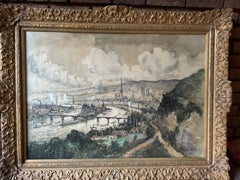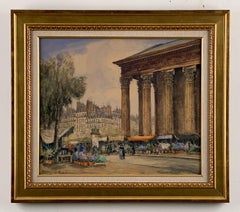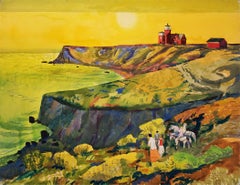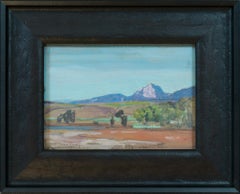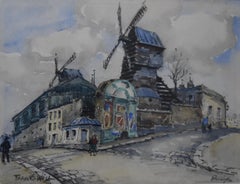Frank Will Drawings and Watercolor Paintings
French, 1900-1951
Frank-Will (1900-1951 Fr.) is the son of the American painter Frank Myers Boggs who was born out of wedlock while his father was living in France. His name Frank was taken from his father and Will from his grandfather. His military service during the war had the job of painting ambulances and other vehicles and was a true bohemian living in Montmartre attending all the local dance halls and a close friend of Gen Paul.to
1
1
1
Overall Width
to
Overall Height
to
3
1
2
2
1
3
1
3
3
1
4
917
406
282
279
2
2
1
Artist: Frank Will
Rouen
By Frank Will
Located in New York, NY
"Rouen" is a watercolor by Frank- Will , it is extremely large in size and from an important place in the history of France. This is where the tower of Joan of Arc is located and wh...
Category
1920s Impressionist Frank Will Drawings and Watercolor Paintings
Materials
Watercolor
View of Montmartre, la place du tertre Paris by Frank Will
By Frank Will
Located in PARIS, FR
Painter and Aquarellist. Nanterre (92) March 13th 1900 – Clichy (Seine) Dec 29th 1950.
He was the son of Frank Boggs, an American citizen. He started his career with the nickname “Wi...
Category
1930s Post-Impressionist Frank Will Drawings and Watercolor Paintings
Materials
Tempera, Watercolor
Place de la Madeleine
By Frank Will
Located in Sheffield, MA
Frank Will
French 1900-1950
Place de la Madeleine
Watercolor on paper
18 by 21 in. w/frame 25 by 27 in.
Signed lower left
Son of painter Frank Myers Boggs. A Figure from montmatr...
Category
1930s Post-Impressionist Frank Will Drawings and Watercolor Paintings
Materials
Watercolor
Related Items
Summertime - Martha's Vineyard - Sunset Golden Sky and Red Lighthouse
By Millard Sheets
Located in Miami, FL
Summertime in Martha's Vineyard is drenched in saturated yellows and reds. People in the foreground look out to the sea. Two people on horseback are masterfully rendered in a loose ...
Category
1960s Post-Impressionist Frank Will Drawings and Watercolor Paintings
Materials
Board, Pencil, Watercolor
Blue Mountains, New Mexico
By Carl Oscar Borg
Located in Stockholm, SE
In this luminous landscape study, Carl Oscar Borg captures the serene beauty of the New Mexican high desert, likely looking toward Mount Taylor, a sacred peak that rises above the su...
Category
Early 20th Century Romantic Frank Will Drawings and Watercolor Paintings
Materials
Gouache
A Northern Vision in Miniature
Located in Stockholm, SE
This exquisitely detailed drawing by Swedish artist Oscar Lycke captures a rustic settlement nestled in the golden highlands of northern Sweden, most likely depicting the traditional...
Category
1910s Impressionist Frank Will Drawings and Watercolor Paintings
Materials
Paper, Crayon, Watercolor, Pencil
Serene Cove Ripples, Mediterranean Seascape Diptych in Blue & White, Cyanotype
By Kind of Cyan
Located in Barcelona, ES
This is an exclusive handprinted limited edition cyanotype.
"Serene Cove Ripples" is a gorgeous original cyanotype diptych showing calming sea ripples in a Mediterranean cove.
Details:
+ Title: Serene Cove Ripples
+ Year: 2022
+ Edition Size: 100
+ Medium: Handmade Cyanotype Print on Watercolor Paper
+ Stamped and Certificate of Authenticity provided
+ Measurements : 100x140 cm (40 x 55.2 in.) Each paper measures 70x100 cm (28x 40 in.) each, a standard frame size
+ All cyanotype prints are made on high-quality Italian watercolor paper
WHAT IS A CYANOTYPE?
The cyanotype (a.k.a. sun-print) process is one of the oldest in the history of photography, dating back to the 1840's.
Cyanotypes were then made famous by Anna Atkins...
Category
2010s Post-Impressionist Frank Will Drawings and Watercolor Paintings
Materials
Lithograph, Paper, Watercolor
A View of the Park in Menton
By Tony Minartz
Located in London, GB
'A View of the Park in Menton', France, watercolour on art paper, by Tony Minartz (circa 1930s). This is a depiction of serenity in a painting. From the South of France, the artist p...
Category
1930s Post-Impressionist Frank Will Drawings and Watercolor Paintings
Materials
Paper, Watercolor
Paul Emile Lecomte (1877-1950) La Route de Naudy, signed watercolor
By Paul Emile Lecomte
Located in Paris, FR
Paul-Emile Lecomte (1877-1950)
La Route de Naudy (The Road to Naudy)
Signed lower left
(titled on the verso of the sheet, but now hidden by the back of the frame)
watercolor on paper...
Category
1920s Post-Impressionist Frank Will Drawings and Watercolor Paintings
Materials
Watercolor
$1,044
H 11.03 in W 14.97 in
Paul Emile Lecomte (1877-1950) A landscape, signed watercolor
By Paul Emile Lecomte
Located in Paris, FR
Paul Emile Lecomte (1877-1950)
A Landscape
Signed lower left
Watercolor on paper
22.5 x 30.5cm
In good condition
Framed: 37.5 x 46 cm
Paul Emile Lecomte (1877– 1950). Painter of wat...
Category
1930s Post-Impressionist Frank Will Drawings and Watercolor Paintings
Materials
Watercolor
$1,050
H 8.86 in W 12.01 in
Paul Emile Lecomte (1877-1950) A landscape by the river, signed watercolor
By Paul Emile Lecomte
Located in Paris, FR
Paul-Emile Lecomte (1877-1950)
Landscape by he river
Signed lower right
watercolor on paper
11.5 x 13.5 cm
Framed : 23 x 29 cm
Paul Emile Lecomte particularly excelled in small-...
Category
1920s Post-Impressionist Frank Will Drawings and Watercolor Paintings
Materials
Watercolor
Second Mesa Hopi Pueblo Arizona Multicolored Southwest Mixed Media Landscape Art
Located in Denver, CO
"Second Mesa (Hopi Pueblo, Arizona)" is a stunning mixed media artwork by Bert Van Bork (1928-2014), created using watercolor, ink, and charcoal on paper...
Category
1980s American Modern Frank Will Drawings and Watercolor Paintings
Materials
Charcoal, Archival Ink, Watercolor
$3,250
H 27 in W 26 in D 1.5 in
Village - Watercolor by French Master - Mid 20th Century
Located in Roma, IT
Village is an original painting in watercolor by an anonymous French artist of the XX century. The state of preservation is good and aged with signs of time on it, with two small hol...
Category
Mid-20th Century Post-Impressionist Frank Will Drawings and Watercolor Paintings
Materials
Watercolor
$450
H 5.32 in W 8.27 in D 0.08 in
Landscape - Original Watercolor on Paper - Early 20th Century
Located in Roma, IT
Landscape is an original drawing in watercolor on paper realized by an anonymous artist of the early 20th Century.
Hand-signed on the lower right, the signature is illegible.
The ...
Category
Early 20th Century Post-Impressionist Frank Will Drawings and Watercolor Paintings
Materials
Watercolor
$332
H 9.45 in W 5.91 in D 0.04 in
Two In The Mountains. Lovers, horizontal, nature, mountain landscape, watercolor
Located in Oslo, NO
The watercolor landscape painting "Two in the Mountains" is created in the most modern watercolor technique on "liquid paper" (on a special primer applied to a regular canvas). It wa...
Category
2010s Post-Impressionist Frank Will Drawings and Watercolor Paintings
Materials
Canvas, Watercolor
$2,966
H 31.5 in W 39.38 in D 1.58 in
Previously Available Items
Frank-Will (1900-1950) Le Moulin de la Galette, Montmartre, Paris, Watercolor
By Frank Will
Located in Paris, FR
Frank-Will (1900-1950)
Le Moulin de la Galette, Montmartre, Paris,
Watercolor on paper.
Signed on the lower left,
18 x 24 cm
Framed : 35 x 41 cm
Le Moulin de La Galette is the se...
Category
1930s Post-Impressionist Frank Will Drawings and Watercolor Paintings
Materials
Watercolor
Frank Will drawings and watercolor paintings for sale on 1stDibs.
Find a wide variety of authentic Frank Will drawings and watercolor paintings available for sale on 1stDibs. You can also browse by medium to find art by Frank Will in paint, watercolor, paper and more. Much of the original work by this artist or collective was created during the 20th century and is mostly associated with the Post-Impressionist style. Not every interior allows for large Frank Will drawings and watercolor paintings, so small editions measuring 27 inches across are available. Customers who are interested in this artist might also find the work of Louis Oscar Griffith, Jehudith Sobel, and Paul César Helleu. Frank Will drawings and watercolor paintings prices can differ depending upon medium, time period and other attributes. On 1stDibs, the price for these items starts at $3,600 and tops out at $10,806, while the average work can sell for $7,000.
Artists Similar to Frank Will
Questions About Frank Will Drawings and Watercolor Paintings
- Who is Frank Mariani?1 Answer1stDibs ExpertApril 5, 2024In the world of art, design and fashion, there are two answers to the question "Who is Frank Mariani?" because two people share that name in these fields. One is furniture designer Frank Mariani, who designed pieces for the Pace Collection, a manufacturer of high-end furniture. There is also the Beverly Hills-based tailor Frank Mariani, who designed suits for Ronald Reagan and a host of celebrities, including Bob Hope, Jimmy Stewart and Henry Fonda. Shop a collection of Frank Mariani furniture on 1stDibs.
- Who was Frank Stella's father?1 Answer1stDibs ExpertOctober 24, 2024Frank Stella's father was also named Frank. Although he worked as a gynecologist, the elder Frank Stella was an art lover and fostered his son's love of painting. Stella's mother, Constance, attended art school and was a landscape painter. On 1stDibs, explore a variety of Frank Stella art from some of the world's top galleries and dealers.
- 1stDibs ExpertOctober 24, 2024Frank Stella's nationality was American. He was born in Malden, Massachusetts, in 1936. Although his parents were also born in the U.S., all four of his grandparents were natives of Italy who immigrated to the country. Stella attended Phillips Academy in Andover, earned a BA from Princeton University and, in 1958, relocated to New York City. He remained there for much of his life and died there in 2024. On 1stDibs, shop a collection of Frank Stella art.
- What is Frank Auerbach style?1 Answer1stDibs ExpertApril 5, 2022Frank Auerbach is a figure painter whose work has been described as expressionist, however, he more accurately fits into the neo-expressionist classification. He’s also been known for creating semi-abstract portraits, which puts him more accurately in the modern art movement. On 1stDibs, find a variety of original artwork from top artists.
- 1stDibs ExpertAugust 29, 2024Frank Stella's philosophy, self-described as "what you see is what you see," reflects his belief that art shouldn't be representational and that its merit was in its actual form and not in any meaning that was assigned to it. He considered paintings on canvas to be objects in their own right, like sculptures, rather than representations. This led him to reject certain formal conventions, eschewing sketches and often using nontraditional materials, like house paint. Shop a range of Frank Stella art on 1stDibs.
- Why is Frank Stella important?1 Answer1stDibs ExpertNovember 20, 2024Frank Stella is important because he was one of the central figures in postwar American art and influenced later artists as a proponent of minimalism and non-representational abstraction. Stella felt that paintings on canvas were objects in their own right, like sculptures. This led him to reject certain formal conventions, eschewing sketches and often using nontraditional materials, like house paint. His approach to art impacted the work of Clement Greenberg, Carl Andre, Kenneth Noland and many others. Find a collection of Frank Stella art on 1stDibs.
- 1stDibs ExpertAugust 29, 2024Frank Stella was famous for his work as an artist. He was one of the central figures in postwar American art. A proponent of Minimalism and non-representational abstraction, Stella was a painter, printmaker and sculptor. Some of his best-known works include Shoubeegi, Harran II and The Marriage of Reason and Squalor II. Find an assortment of Frank Stella art on 1stDibs.
- Why is Frank Stella famous?1 Answer1stDibs ExpertOctober 24, 2024Frank Stella is famous for his work as an artist. He was one of the central figures in postwar American art. A proponent of Minimalism and non-representational abstraction, Stella was a painter, printmaker and sculptor. His work is in the collections of numerous major museums around the world, including New York’s Museum of Modern Art and Metropolitan Museum of Art; the Menil Collection in Houston; the Hirshhorn Museum and Sculpture Garden in Washington, D.C. and the San Francisco Museum of Modern Art. He was awarded the National Medal of Arts by President Obama in 2009 and was given the Lifetime Achievement Award in Contemporary Sculpture by the International Sculpture Center in 2011. He died on May 4, 2024. Some of his best-known works include Harran II, Shoubeegi and “The Marriage of Reason and Squalor” series. On 1stDibs, shop a selection of Frank Stella art.
- 1stDibs ExpertAugust 29, 2024Frank Stella influenced art by encouraging the spread of Minimalism, an extreme form of abstraction that focuses on forms rather than meaning. Through his work, Stella challenged the notion that art must be a representation of something else. He believed that the art itself was the only true meaning of a piece. His philosophy influenced other artists and architects, such as Frank Gehry, Timothy App and Carl Andre. On 1stDibs, shop a range of Frank Stella art.
- 1stDibs ExpertFebruary 1, 2024The style of Frank Lloyd Wright’s work is Prairie style. The architect pioneered the style, which draws inspiration from the natural beauty of the landscapes of the Midwest region of the U.S. Wright's design philosophy emphasized organic architecture, with buildings existing in harmony with their natural surroundings. His approach to architectural design had a profound influence on the shape of modern life, both while he was actively designing buildings and during the decades that followed. Shop a diverse assortment of Frank Lloyd Wright furniture on 1stDibs.
- 1stDibs ExpertApril 5, 2022Frank Lloyd Wright broke away from Victorian-era architecture and created “Prairie-Style” out of the belief that there should be fewer, larger rooms that flowed easily. He was also a key player in the Art Deco movement. Shop a collection of expertly vetted Frank Lloyd Wright pieces from some of the world’s top sellers on 1stDibs.
- 1stDibs ExpertFebruary 27, 2024The name of Frank Gehry's chair depends on which piece you're referring to, as the designer has produced quite a few chairs over the course of his career. Arguably, his most famous chair is the S-shaped Wiggle chair, crafted out of corrugated cardboard. He also designed several chairs out of ribbon-like pieces of bent wood, such as the armless, low-backed Hat Trick chair, the curvy Cross Check chair and the tall High Sticking chair. On 1stDibs, find a collection of vintage Frank Gehry chairs.
- 1stDibs ExpertMarch 15, 2024A painter is the type of artist that Frank Bowling is. He is generally considered to be an Abstract Expressionist, and he tends to incorporate themes and symbols inspired by his Guyanese heritage. Some of his best-known works include Who's Afraid of Barney Newman, Spreadout Ron Kitaj, Middle Passage, Sacha Jason Guyana Dreams, Pondlife, Late Blue and Blue Trane. On 1stDibs, shop a range of Frank Bowling art.
- 1stDibs ExpertOctober 15, 2024You can see Frank Stella art at a number of museums. Some institutions in the U.S. that have Stella pieces in their permanent collections include the San Francisco Museum of Modern Art in San Francisco, California; the Museum of Modern Art (MoMA) in New York City, New York and the Chrysler Museum of Art in Norfolk, Virginia. In addition, museums may host temporary exhibitions of the artist's work. On 1stDibs, find a selection of Frank Stella art.
- 1stDibs ExpertOctober 24, 2024Frank Stella went to college at Princeton University, earning a bachelor of arts from the institution. While there, he studied art and color theory with Josef Albers and Hans Hofmann. Stella frequented New York galleries as a student and was intrigued by the work of Jackson Pollock and Franz Kline, both of whom were at the height of their creative powers in the late 1950s. After moving to New York in 1958, Stella gravitated toward the geometric abstraction and restrained painting style of Barnett Newman and Jasper Johns. On 1stDibs, shop a collection of Frank Stella art.
- 1stDibs ExpertOctober 24, 2024Frank Stella used a variety of techniques. The American artist eschewed sketches for his paintings and often used nontraditional materials, like house paint. In 1960, he began introducing color into his work and using unconventionally shaped canvases to complement his compositions. Following a solo show at the Museum of Modern Art in New York in 1970, Stella began working in three dimensions, adding relief elements to paintings, which could be considered wall-mounted sculptures. Stella’s 1970–73 “Polish Village” series was inspired by documentary photographs and architectural drawings of Polish synagogues that had been destroyed by the Nazis during World War II. The resulting works — composed primarily of paint and cloth on plywood — are more rugged and less polished than his previous series. Herman Melville's Moby-Dick was Stella's muse for a series of three-dimensional works he created in the 1980s in which waveforms, architectural elements and Platonic solids played a prominent role. During this period, Stella embraced a new, exuberant style exemplified in his piece La Scienza della Fiacca. In addition to paintings and sculptural works, the artist also produced prints using lithography, serigraphy, etching and offset lithography techniques. Explore an assortment of Frank Stella art on 1stDibs.
- 1stDibs ExpertOctober 24, 2024Frank Stella made Harran II because of his interest in moving his work away from representation toward minimalist abstractions. He believed paintings on canvas were objects in their own right, like sculptures, rather than symbols for something else. Harran II was a part of Stella's Protractor series, characterized by colorful circles and arcs. Named after the ancient cities whose circular plans Stella had noticed while traveling in the Middle East during the 1960s, these works usually comprise several canvases set flush against one another so that the geometric figures in each section come together in a larger, more complex whole. In the case of Harran II, the name is a nod to a city in Turkey where Stella was inspired by intricate, colorful tile mosaics. Find a variety of Frank Stella art on 1stDibs.
- 1stDibs ExpertNovember 20, 2024Here are three interesting facts about Frank Stella. First, Stella considered paintings on canvas as objects in their own right, like sculptures, rather than representations. This led him to reject certain formal conventions, eschewing sketches and often using nontraditional materials, like house paint. Secondly, Stella created a series of works named after the ancient cities whose circular plans Stella had noticed while traveling in the Middle East during the 1960s. Called the “Protractor” series, these works usually involved several canvases set flush against one another so that the geometric figures in each section came together in a larger, more complex whole. In addition, Stella was awarded the National Medal of Arts by President Obama in 2009 and was given the Lifetime Achievement Award in Contemporary Sculpture by the International Sculpture Center in 2011. On 1stDibs, shop a wide variety of Frank Stella art.
- 1stDibs ExpertFebruary 27, 2024The material used in Frank Gehry's Wiggle chair is the type of corrugated cardboard that is typically reserved for making architectural models. The piece comes from Gehry's Easy Edges collection of paper furniture. Gehry was inspired to produce the Wiggle chair and the rest of his Easy Edges pieces because he believed that the seating options available to consumers when the chair debuted in 1972 were too expensive. Find a selection of vintage Frank Gehry furniture on 1stDibs.
- 1stDibs ExpertFebruary 27, 2024Frank Lloyd Wright used a variety of materials. For his homes and commercial buildings, the American architect favored natural materials and obtained them from local sources whenever possible. Some materials commonly featured in Wright's buildings include concrete, zinc, glass bricks, stone and wood. Wright’s wooden chairs and tables for his “Prairie Houses” of the early 1900s have sleek, attenuated forms, influenced by both the simplicity of traditional Japanese design and the work of Gustav Stickley and other designers of the Arts and Crafts movement. His desks and chairs for Johnson Wax have a streamlined look and feature tubular steel. Shop a variety of Frank Lloyd Wright furniture on 1stDibs.
